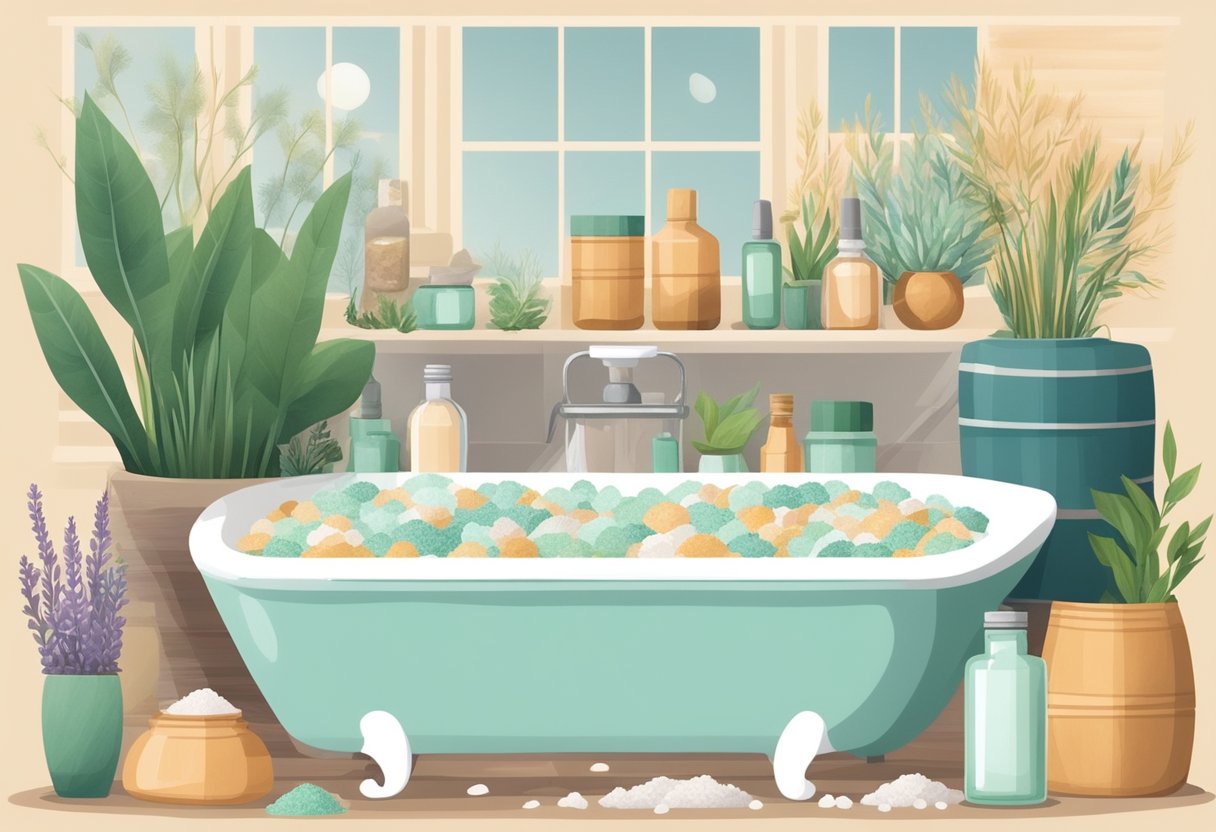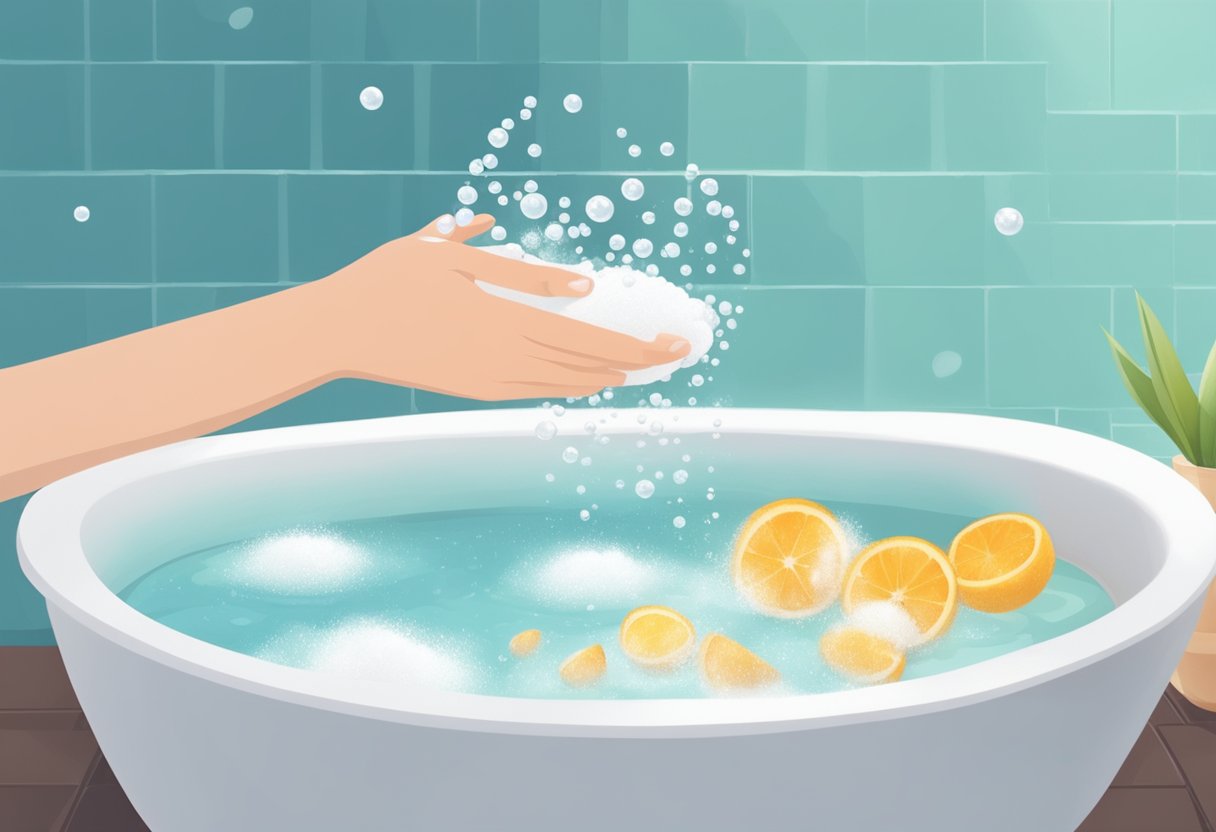Epsom salt is a popular ingredient for bath soaks due to its therapeutic and soothing properties. However, if you run out of Epsom salt or prefer to use a different alternative, there are several options available. This article will explore some of the best substitutes for Epsom salt in bath soaks.

One of the most popular alternatives to Epsom salt is sea salt. Sea salt is a natural exfoliant that can help to soften and moisturize the skin. It also contains many of the same minerals as Epsom salt, such as magnesium and potassium, which can help to soothe sore muscles and joints. Other options for creating a rejuvenating body soak include essential oils, baking soda, and apple cider vinegar.
If you have sensitive skin or are looking for a more natural alternative to Epsom salt, oatmeal can also be used instead. Oatmeal is a gentle exfoliant that can help to soothe irritated skin and provide relaxation. It can also help to reduce inflammation and redness, making it an excellent choice for those with eczema or other skin conditions. Overall, there are several alternatives to Epsom salt that can be just as effective in creating a relaxing and rejuvenating bath soak.
Benefits of Bath Additives

Bath additives can enhance the relaxation and therapeutic effects of a bath. They can also provide relief from various conditions. Here are some of the benefits of using bath additives:
-
Relaxation: Bath additives such as essential oils, lavender, and chamomile can help calm the mind and body, reduce stress, and promote relaxation.
-
Skin Care: Bath additives such as oatmeal, baking soda, and sea salt can help soothe irritated skin, reduce inflammation, and improve skin texture.
-
Muscle and Joint Pain Relief: Bath additives such as Epsom salt, ginger, and arnica can help relieve muscle and joint pain, reduce inflammation, and improve mobility.
-
Detoxification: Bath additives such as apple cider vinegar, bentonite clay, and activated charcoal can help remove toxins from the body, improve digestion, and boost the immune system.
-
Improved Sleep: Bath additives such as magnesium flakes, valerian root, and hops can help improve sleep quality, reduce insomnia, and promote relaxation.
It is important to note that not all bath additives are suitable for everyone. Some people may have allergies or sensitivities to certain ingredients. It is recommended to do a patch test before using a new bath additive. It is also important to follow the instructions on the product label and not exceed the recommended dosage.
Sea Salt Alternatives

Sea salt is another popular alternative to Epsom salt for a relaxing bath. It contains high levels of minerals such as magnesium, potassium, and calcium, which can be readily absorbed by the skin. Here are some of the most popular sea salt alternatives to Epsom salt:
-
Pink Himalayan Salt: This type of salt is known for its beautiful pink color and is rich in minerals such as magnesium, potassium, and calcium. It is believed to have detoxifying properties and can help to soothe sore muscles and joints.
-
Dead Sea Salt: This type of salt is harvested from the Dead Sea, which is known for its high salt concentration and mineral content. It is believed to have therapeutic properties and can help to relieve symptoms of skin conditions such as psoriasis and eczema.
-
Celtic Sea Salt: This type of salt is harvested from the coastal region of Brittany, France, and is known for its high mineral content. It contains minerals such as magnesium, potassium, and calcium, and is believed to have detoxifying properties.
-
Black Lava Sea Salt: This type of salt is harvested from Hawaii and is known for its distinctive black color. It contains activated charcoal, which can help to draw out impurities from the skin and provide a deep cleansing effect.
When using sea salt as a bath salt, it is important to dissolve it in warm water before adding it to the bath. This will ensure that the salt is evenly distributed and will not irritate the skin. It is also recommended to soak in the bath for at least 20 minutes to allow the minerals to be absorbed by the skin.
Overall, sea salt can be a great alternative to Epsom salt for a relaxing and therapeutic bath. However, it is important to choose a high-quality salt and to follow proper usage instructions to avoid any potential side effects.
Baking Soda Solutions

Baking soda is a common household item that has many uses, including as a substitute for Epsom salt in a bath. It is a natural alkaline compound that can help soothe and soften the skin. Here are some ways to use baking soda in your bath:
1. Baking Soda and Sea Salt Bath
Mixing baking soda with sea salt can create a relaxing and detoxifying bath. Sea salt is a natural exfoliant that can help remove dead skin cells and unclog pores. To make this bath, add 1 cup of baking soda and 1 cup of sea salt to your bathwater. Soak for 20-30 minutes and rinse off with warm water.
2. Baking Soda and Essential Oil Bath
Adding essential oils to your bath can help promote relaxation and relieve stress. To make this bath, add 1 cup of baking soda and a few drops of your favorite essential oil to your bathwater. Soak for 20-30 minutes and rinse off with warm water.
3. Baking Soda and Oatmeal Bath
Oatmeal is a natural skin soother that can help relieve itching and inflammation. To make this bath, blend 1 cup of oatmeal into a fine powder and mix with 1 cup of baking soda. Add the mixture to your bathwater and soak for 20-30 minutes.
Overall, baking soda is a versatile and affordable alternative to Epsom salt in a bath. It can help soothe the skin, promote relaxation, and relieve stress. However, it is important to note that baking soda may not be suitable for everyone, especially those with sensitive skin. It is always best to consult with a healthcare professional before trying any new bath solutions.
Essential Oil Blends

When it comes to creating a relaxing bath without using Epsom salt, essential oils are a great alternative. Essential oils are highly concentrated plant extracts that can be added to bathwater to provide a range of benefits, from relaxation to pain relief.
Lavender Oil
Lavender oil is one of the most popular essential oils for relaxation. It has a calming effect on the mind and body and can help to reduce stress and anxiety. Additionally, lavender oil has anti-inflammatory properties, making it a great choice for those with sore muscles or joint pain.
To use lavender oil in a bath, add a few drops to warm water and mix well. For an even more relaxing experience, combine lavender oil with a carrier oil like coconut or jojoba oil and add to bathwater.
Tea Tree Oil
Tea tree oil is another great option for those looking to create a relaxing bath without Epsom salt. It has antimicrobial properties, making it a great choice for those with skin conditions like acne or eczema. Additionally, tea tree oil has a refreshing scent that can help to clear the mind and promote relaxation.
To use tea tree oil in a bath, add a few drops to warm water and mix well. For an even more invigorating experience, combine tea tree oil with a carrier oil like almond or grapeseed oil and add to bathwater.
Eucalyptus Oil
Eucalyptus oil is a popular choice for those looking to create a spa-like experience at home. It has a refreshing scent that can help to clear the sinuses and promote respiratory health. Additionally, eucalyptus oil has anti-inflammatory properties, making it a great choice for those with sore muscles or joint pain.
To use eucalyptus oil in a bath, add a few drops to warm water and mix well. For an even more relaxing experience, combine eucalyptus oil with a carrier oil like avocado or olive oil and add to bathwater.
Herbal Infusions

When it comes to alternative options for Epsom salt, herbal infusions are a great option. The following subsections will discuss some of the most popular herbal infusions that can be used instead of Epsom salt for a relaxing bath.
Chamomile
Chamomile is a popular herb that is known for its calming and soothing properties. It can be used in a bath to help reduce stress and anxiety, as well as to soothe skin irritations. To use chamomile in a bath, simply brew a strong cup of chamomile tea and add it to the bathwater. Alternatively, you can add fresh or dried chamomile flowers directly to the bathwater.
Green Tea
Green tea is another great option for those looking for an alternative to Epsom salt. It is rich in antioxidants and can help to detoxify the body. To use green tea in a bath, simply brew a strong cup of green tea and add it to the bathwater. Alternatively, you can add green tea leaves directly to the bathwater.
Peppermint
Peppermint is a refreshing herb that is known for its cooling and soothing properties. It can be used in a bath to help relieve muscle tension and soreness, as well as to invigorate the senses. To use peppermint in a bath, simply brew a strong cup of peppermint tea and add it to the bathwater. Alternatively, you can add fresh or dried peppermint leaves directly to the bathwater.
Overall, herbal infusions are a great option for those looking for an alternative to Epsom salt in their bath. They provide a variety of benefits, from calming and soothing the mind to invigorating the senses and soothing skin irritations.
Vinegar Baths

Vinegar baths are another alternative to Epsom salt baths that can provide a range of benefits. Apple cider vinegar, in particular, is known for its anti-inflammatory and anti-fungal properties, making it a great option for those looking to soothe irritated skin or fight off infections.
To take a vinegar bath, simply add one to two cups of apple cider vinegar to your bathwater and soak for 20-30 minutes. Be sure to mix the vinegar into the water thoroughly to avoid any skin irritation.
In addition to its therapeutic benefits, vinegar baths can also help to balance the pH of your skin and hair, leaving them feeling soft and smooth. Plus, vinegar is a natural deodorizer, so it can help to eliminate any unwanted odors from your body or bathwater.
Overall, vinegar baths are a simple and effective way to reap the benefits of Epsom salt baths without actually using Epsom salt. Whether you’re looking to soothe sore muscles, detoxify your body, or simply relax and unwind, a vinegar bath is definitely worth a try.
Clay Baths

Clay baths are another alternative to Epsom salt baths. Clay is a natural substance that is rich in minerals and has been used for centuries for its therapeutic benefits. Clay baths can help to detoxify the body, soothe sore muscles, and improve skin health.
There are different types of clay that can be used for clay baths, including bentonite clay, kaolin clay, and French green clay. Bentonite clay is a popular choice because it has a high absorption rate and can help to draw out toxins from the body. Kaolin clay is gentler on the skin and can help to soothe irritation and inflammation. French green clay is rich in minerals and can help to improve skin health.
To prepare a clay bath, add 1-2 cups of clay powder to warm bath water and mix well. Soak in the bath for 20-30 minutes to allow the clay to work its magic. After the bath, rinse off with warm water and pat dry.
It’s important to note that clay baths can be quite messy, so it’s best to use a drain catcher to prevent any clay from clogging your drain. Also, be sure to drink plenty of water before and after the bath to help flush out toxins from your body.
Overall, clay baths can be a great alternative to Epsom salt baths for those looking to detoxify their body and improve their skin health.
Oatmeal Baths

Oatmeal baths are a natural and effective alternative to Epsom salt baths. Oatmeal has been used for centuries to soothe irritated skin and provide relaxation. It contains anti-inflammatory compounds that can reduce redness and itching, making it an ideal choice for people with sensitive skin.
To make an oatmeal bath, simply grind one cup of plain, uncooked oatmeal into a fine powder using a food processor or blender. Add the oatmeal powder to a warm bath and stir until it is evenly distributed. Soak in the bath for 15-20 minutes, then rinse off with warm water.
Alternatively, you can place the oatmeal powder in a muslin bag or cheesecloth and tie it to the faucet while the bath is running. This will allow the water to flow through the bag and infuse the bath with the soothing properties of oatmeal.
Oatmeal baths can also be enhanced by adding other natural ingredients such as honey, coconut oil, or essential oils. These can help to moisturize and nourish the skin while providing a relaxing and aromatic experience. However, it is important to note that some people may be allergic to certain ingredients, so it is always best to test a small patch of skin before using any new products.
Overall, oatmeal baths are a gentle and effective alternative to Epsom salt baths that can help to soothe and nourish the skin. They are easy to make and can be customized to suit individual preferences and needs.
Magnesium Flakes

Magnesium flakes are a popular alternative to Epsom salt for bath soaks. They are made from magnesium chloride, which is a highly soluble and absorbable form of magnesium. When magnesium flakes are dissolved in water, they create a solution that is easily absorbed through the skin.
Magnesium flakes are known for their ability to alleviate muscle soreness, reduce stress, and promote healthier skin. They are often used as a holistic wellness experience, paired with other natural ingredients like sage.
Compared to Epsom salt, magnesium flakes have a different mineral composition. While Epsom salt is made from magnesium sulfate, magnesium flakes are made from magnesium chloride. This difference in composition affects the way the minerals are absorbed by the body.
Magnesium flakes are also more expensive than Epsom salt, but they are often considered to be a higher quality product. They are more easily absorbed by the body, and they are less likely to cause skin irritation or dryness.
Overall, magnesium flakes are a great alternative to Epsom salt for bath soaks. They offer a range of benefits for the body and mind, and they are a natural way to promote relaxation and wellness.
DIY Bath Bomb Recipes

Bath bombs are a popular way to add a little luxury to your bath time routine. They are easy to make at home and can be customized to suit your preferences. However, some bath bomb recipes call for Epsom salt, which not everyone may have on hand. Here are some DIY bath bomb recipes that do not require Epsom salt:
Coconut Oil Bath Bomb Recipe
This recipe is simple and requires only a few ingredients. It uses coconut oil instead of Epsom salt to provide moisture to the skin.
Ingredients:
- 1 cup baking soda
- 1/2 cup citric acid
- 1/2 cup cornstarch
- 1/2 cup coconut oil
- 20-30 drops essential oil (optional)
- Food coloring (optional)
Instructions:
- In a large bowl, mix together the baking soda, citric acid, and cornstarch.
- In a separate bowl, melt the coconut oil in the microwave or on the stove.
- Add the essential oil and food coloring to the melted coconut oil and stir to combine.
- Slowly pour the wet ingredients into the dry ingredients, stirring constantly.
- Mix until the mixture resembles wet sand and holds together when squeezed.
- Press the mixture into bath bomb molds and let dry for at least 24 hours before using.
Oatmeal Bath Bomb Recipe
This recipe uses oatmeal instead of Epsom salt to provide a soothing and moisturizing bath experience.
Ingredients:
- 1 cup baking soda
- 1/2 cup citric acid
- 1/2 cup cornstarch
- 1/2 cup oatmeal
- 1/4 cup coconut oil
- 20-30 drops essential oil (optional)
- Food coloring (optional)
Instructions:
- In a large bowl, mix together the baking soda, citric acid, cornstarch, and oatmeal.
- In a separate bowl, melt the coconut oil in the microwave or on the stove.
- Add the essential oil and food coloring to the melted coconut oil and stir to combine.
- Slowly pour the wet ingredients into the dry ingredients, stirring constantly.
- Mix until the mixture resembles wet sand and holds together when squeezed.
- Press the mixture into bath bomb molds and let dry for at least 24 hours before using.
Milk Bath Bomb Recipe
This recipe uses powdered milk instead of Epsom salt to provide a moisturizing and nourishing bath experience.
Ingredients:
- 1 cup baking soda
- 1/2 cup citric acid
- 1/2 cup cornstarch
- 1/2 cup powdered milk
- 1/4 cup coconut oil
- 20-30 drops essential oil (optional)
- Food coloring (optional)
Instructions:
- In a large bowl, mix together the baking soda, citric acid, cornstarch, and powdered milk.
- In a separate bowl, melt the coconut oil in the microwave or on the stove.
- Add the essential oil and food coloring to the melted coconut oil and stir to combine.
- Slowly pour the wet ingredients into the dry ingredients, stirring constantly.
- Mix until the mixture resembles wet sand and holds together when squeezed.
- Press the mixture into bath bomb molds and let dry for at least 24 hours before using.
These DIY bath bomb recipes are easy to make and do not require Epsom salt. They can be customized with your favorite essential oils and food coloring for a truly personalized bath experience.
Frequently Asked Questions

What are suitable substitutes for Epsom salt in a bath?
There are several alternatives to Epsom salt that can be used in a bath. Some of the most popular options include sea salt, Himalayan salt, Dead Sea salt, and baking soda. These salts are rich in minerals and can help to soothe sore muscles and promote relaxation.
Can baking soda be used as an alternative to Epsom salt for baths?
Yes, baking soda can be used as an alternative to Epsom salt for baths. Baking soda is a natural exfoliant and can help to soften and soothe the skin. To use baking soda in a bath, simply add 1-2 cups to warm running water and soak for 20-30 minutes.
Are there any alternatives to Epsom salt for foot soaks?
Yes, there are several alternatives to Epsom salt for foot soaks. Some of the most popular options include apple cider vinegar, tea tree oil, and lavender oil. These ingredients can help to soothe and moisturize the feet, while also providing a relaxing and rejuvenating experience.
What can I use in place of Epsom salt for sitz baths?
For sitz baths, it is best to use ingredients that are gentle and soothing to the skin. Some suitable alternatives to Epsom salt include chamomile tea, witch hazel, and calendula oil. These ingredients can help to reduce inflammation and promote healing in the affected area.
Can table salt be used instead of Epsom salt for bath purposes?
While table salt can be used in a bath, it is not recommended as a substitute for Epsom salt. Table salt is much harsher on the skin and can cause irritation and dryness. It is best to stick with natural salts, such as sea salt or Himalayan salt, for bath purposes.
What other options do I have for bath bombs without Epsom salt?
There are several options for bath bombs without Epsom salt. Some popular alternatives include citric acid, baking soda, and cornstarch. These ingredients can help to create a fizzing effect in the bath and provide a relaxing and rejuvenating experience.

